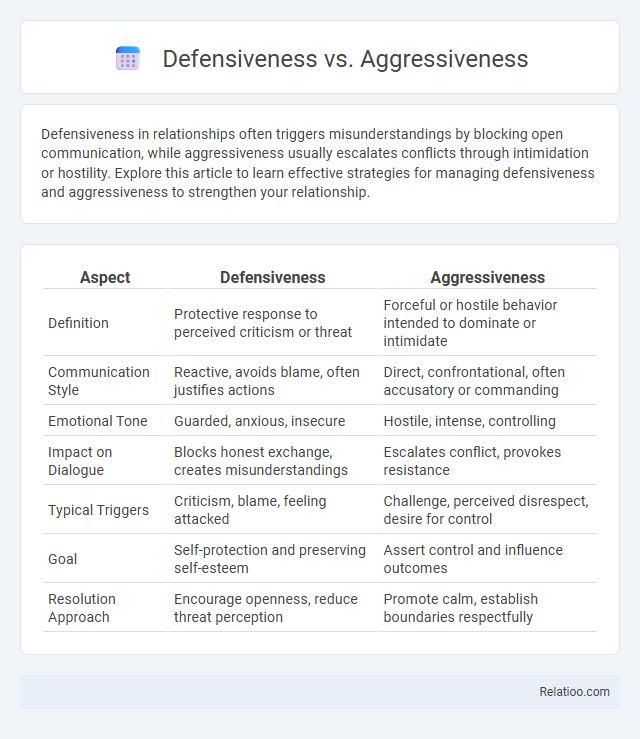Defensiveness in relationships often triggers misunderstandings by blocking open communication, while aggressiveness usually escalates conflicts through intimidation or hostility. Explore this article to learn effective strategies for managing defensiveness and aggressiveness to strengthen your relationship.
Table of Comparison
| Aspect | Defensiveness | Aggressiveness |
|---|---|---|
| Definition | Protective response to perceived criticism or threat | Forceful or hostile behavior intended to dominate or intimidate |
| Communication Style | Reactive, avoids blame, often justifies actions | Direct, confrontational, often accusatory or commanding |
| Emotional Tone | Guarded, anxious, insecure | Hostile, intense, controlling |
| Impact on Dialogue | Blocks honest exchange, creates misunderstandings | Escalates conflict, provokes resistance |
| Typical Triggers | Criticism, blame, feeling attacked | Challenge, perceived disrespect, desire for control |
| Goal | Self-protection and preserving self-esteem | Assert control and influence outcomes |
| Resolution Approach | Encourage openness, reduce threat perception | Promote calm, establish boundaries respectfully |
Understanding Defensiveness and Aggressiveness
Understanding defensiveness involves recognizing it as a self-protective response triggered when Your self-image feels threatened, often leading to withdrawal or justification rather than open dialogue. Aggressiveness, in contrast, manifests as an outward, hostile behavior aimed at dominating or controlling others, frequently escalating conflicts. Differentiating between these reactions allows for better emotional regulation and improved communication strategies in challenging interpersonal situations.
Key Differences Between Defensiveness and Aggressiveness
Defensiveness is a reaction to perceived threats, characterized by protecting oneself verbally or emotionally without intending harm, whereas aggressiveness involves intention to dominate or harm others through confrontational or hostile behavior. Your ability to recognize defensiveness as self-preservation rather than aggression helps improve communication and reduce conflict escalation. Key differences include the intent behind the behavior and the impact on interpersonal relationships, with defensiveness seeking to shield and aggressiveness aiming to control or attack.
Psychological Roots of Defensive Behavior
Defensive behavior originates from psychological mechanisms aimed at protecting Your self-esteem and sense of security when faced with perceived threats or criticism. It often stems from unresolved anxiety, fear of rejection, or past trauma, causing heightened sensitivity and reactive responses. Understanding these root causes helps distinguish defensiveness from aggressiveness, which is driven more by dominance and control rather than vulnerability.
Causes and Triggers of Aggressive Responses
Aggressive responses are often triggered by perceived threats to self-esteem, unresolved past conflicts, or feelings of vulnerability that evoke defensive mechanisms. Causes include stress, fear of loss of control, and misinterpretation of others' intentions as hostile or disrespectful. Understanding these triggers aids in differentiating between genuine assertiveness and harmful aggression in interpersonal communication.
Communication Patterns: Defensive vs Aggressive
Defensive communication involves protecting oneself by deflecting blame or avoiding responsibility to minimize perceived threats, often leading to closed or evasive responses. Aggressive communication, in contrast, is marked by dominating or hostile language aimed at overpowering others, which can escalate conflicts and damage relationships. Understanding how your communication style influences interactions helps foster constructive, clear dialogue and reduces misunderstandings.
Impact on Relationships and Social Dynamics
Defensiveness often triggers misunderstandings and emotional distance, while aggressiveness can escalate conflicts and damage trust in relationships. Passive behavior, though less confrontational, may lead to unresolved issues and resentment, undermining social dynamics. You can improve your interactions by recognizing these patterns and adopting open communication strategies to foster healthier connections.
Recognizing Defensiveness in Yourself and Others
Recognizing defensiveness involves observing verbal cues such as interrupting, shifting blame, or justifying actions excessively, alongside physical signs like crossed arms or avoiding eye contact, which indicate an instinct to protect oneself from perceived criticism. Defensiveness differs from aggressiveness, where the latter manifests as overt hostility, threats, or confrontational behavior aimed at dominating or attacking others. Understanding these distinctions aids in managing interpersonal conflicts effectively by identifying when emotional self-protection escalates to aggression.
Identifying Signs of Aggressiveness
Signs of aggressiveness include hostile body language, such as clenched fists, intense eye contact, and a raised voice. Aggressive individuals often interrupt others, use accusatory language, and display impatience or irritability. Recognizing these behaviors enables effective communication management and conflict resolution.
Managing and Transforming Defensive Reactions
Managing and transforming defensive reactions requires recognizing the distinct triggers of defensiveness and aggressiveness in communication, enabling a shift from reactive behaviors to constructive dialogue. Techniques such as active listening, empathy, and self-awareness help diffuse emotional tension and redirect responses toward collaboration, reducing conflicts rooted in perceived threats. Developing emotional regulation skills and fostering an open mindset are essential for converting defensive impulses into opportunities for mutual understanding and problem-solving.
Building Assertive Communication Skills
Building assertive communication skills requires distinguishing between defensiveness, aggressiveness, and true assertiveness to foster respectful and clear interactions. Defensiveness often stems from fear of criticism and leads to shutting down or counterattacking, while aggressiveness imposes demands or attacks others, undermining trust and collaboration. True assertiveness balances confidence and empathy, promoting honest expression of needs and boundaries without infringing on others' rights, critical for effective conflict resolution and relationship building.

Infographic: Defensiveness vs Aggressiveness
 relatioo.com
relatioo.com